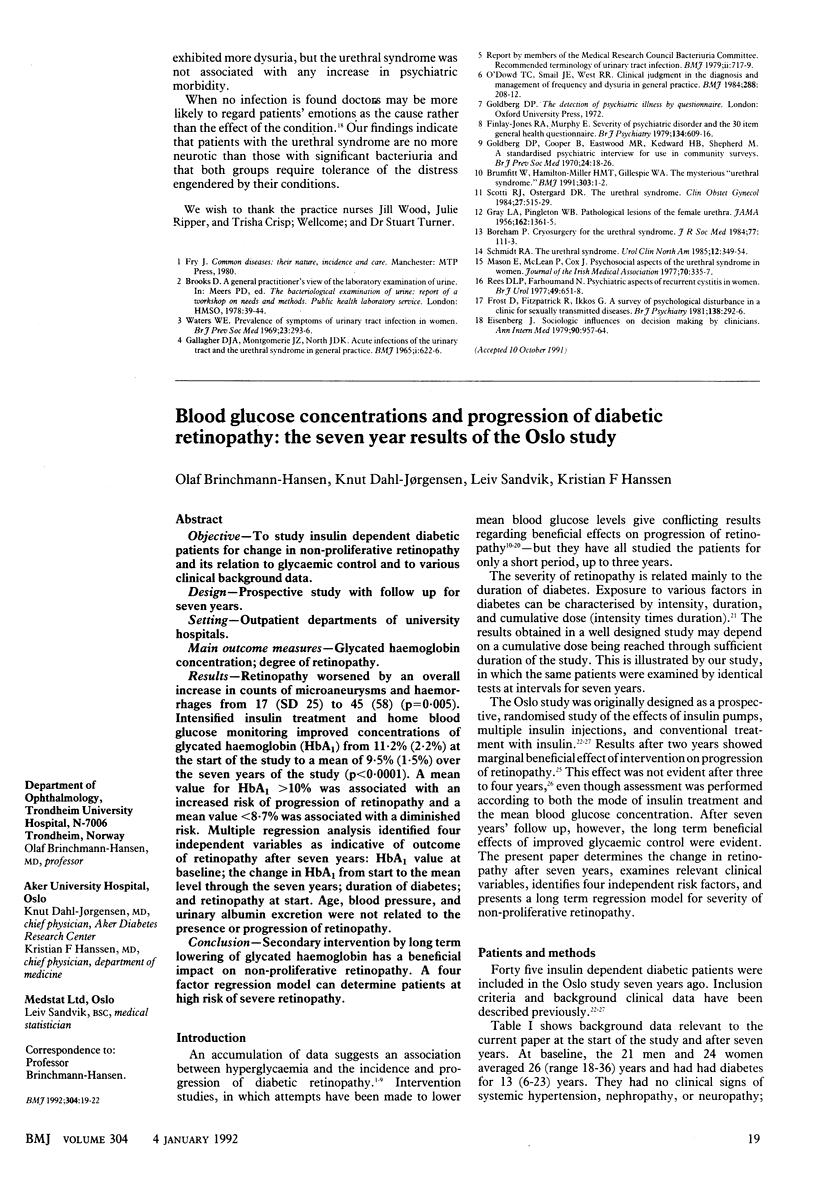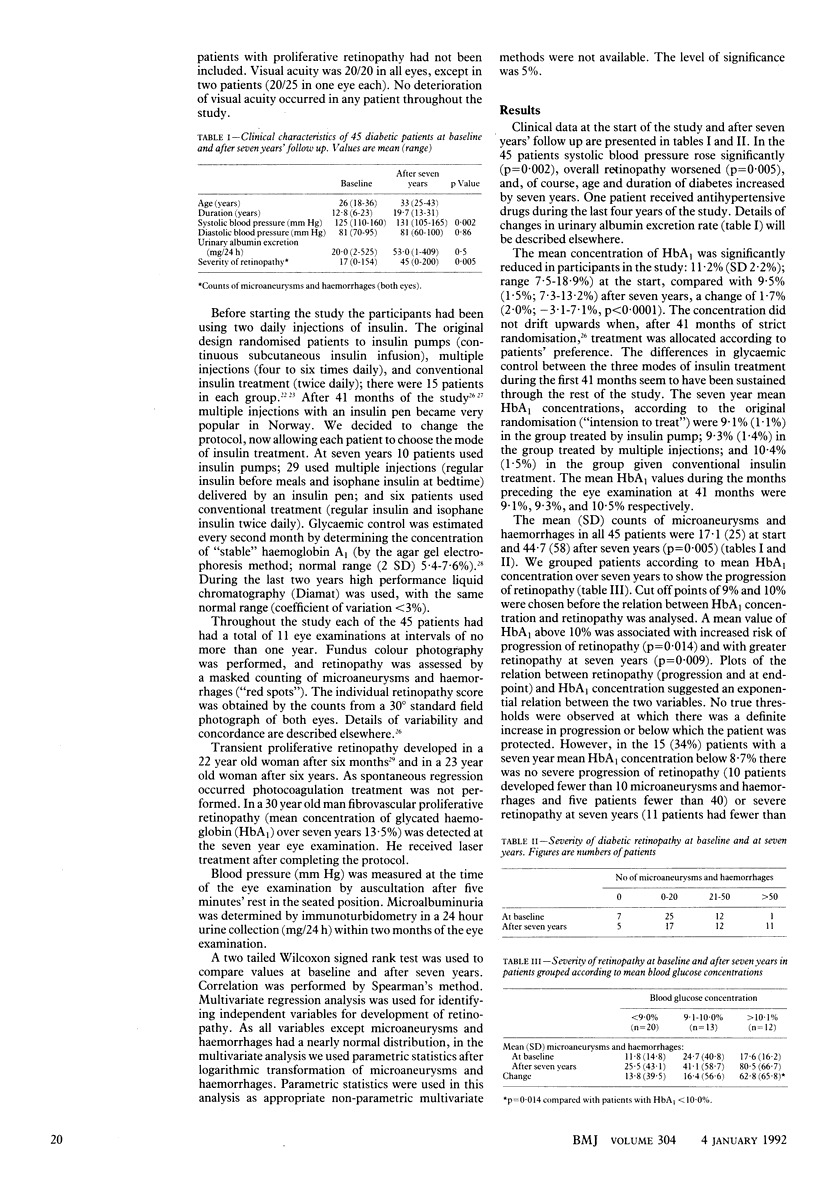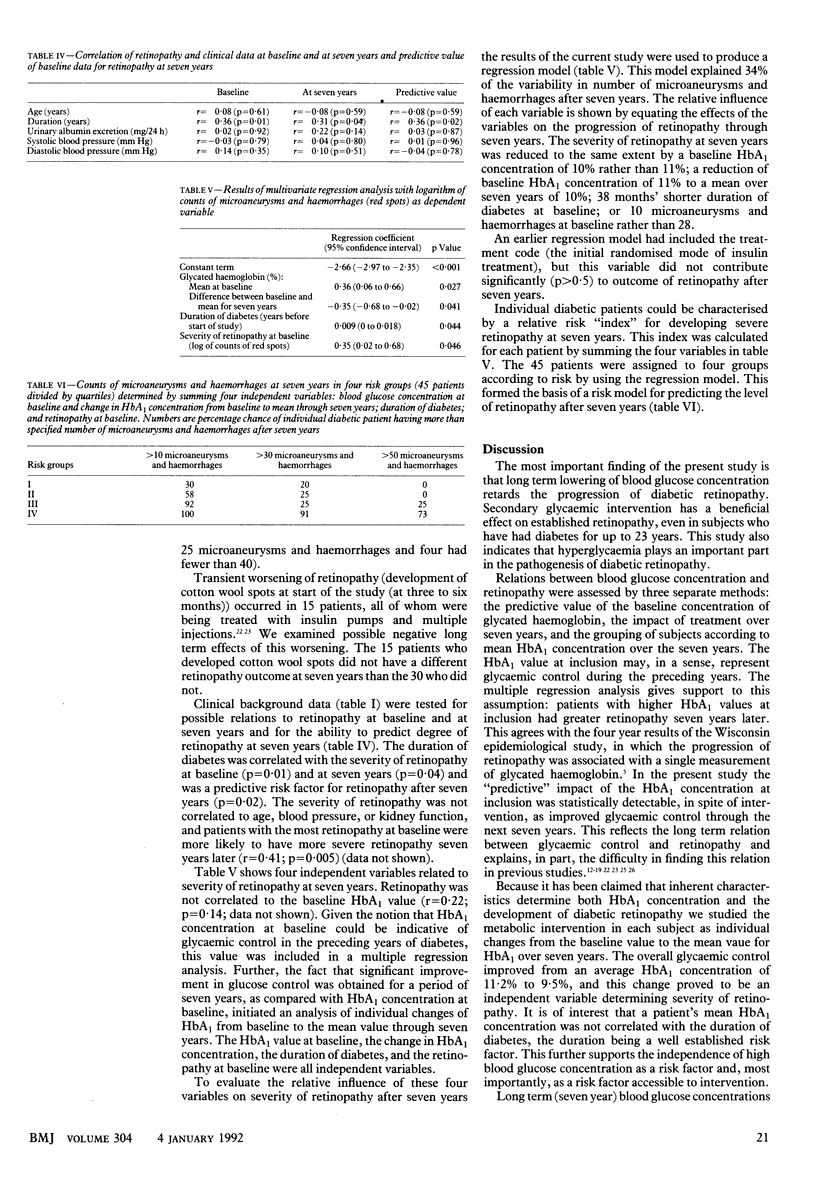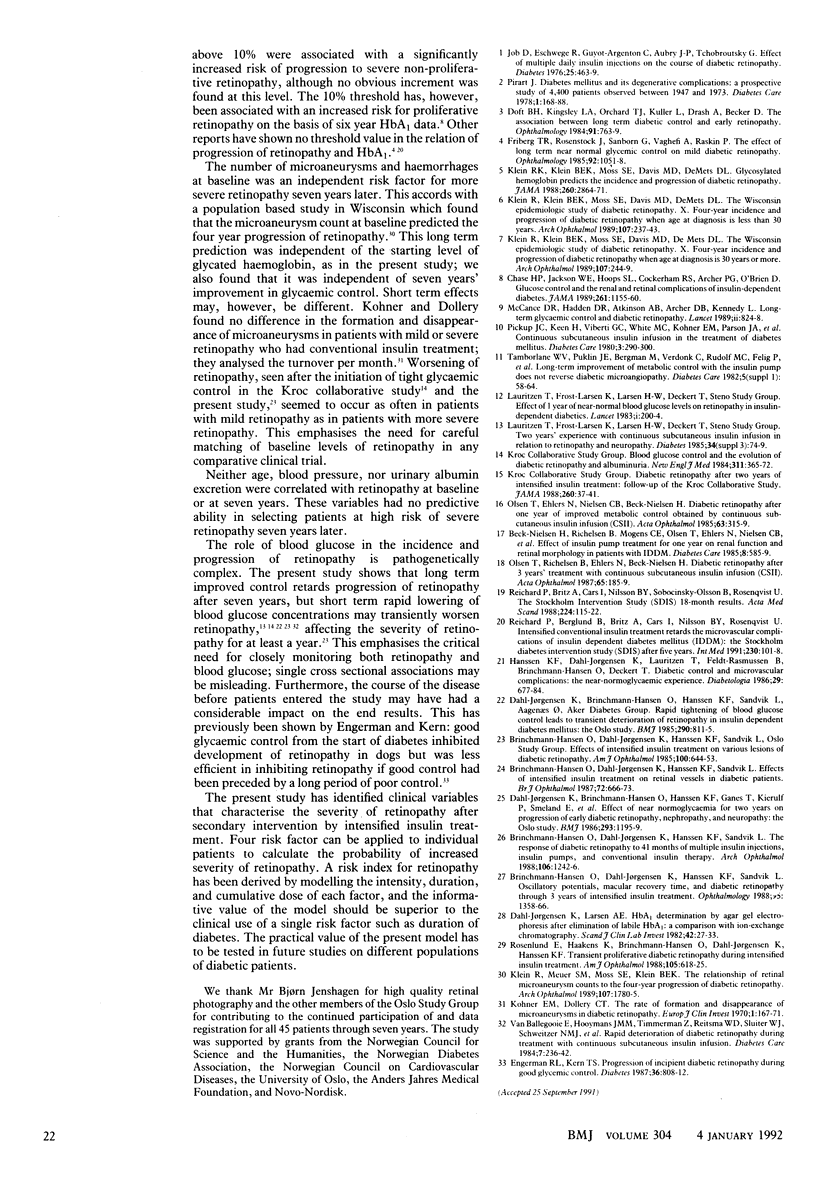Abstract
OBJECTIVE--To study insulin dependent diabetic patients for change in non-proliferative retinopathy and its relation to glycaemic control and to various clinical background data. DESIGN--Prospective study with follow up for seven years. SETTING--Outpatient departments of university hospitals. MAIN OUTCOME MEASURES--Glycated haemoglobin concentration; degree of retinopathy. RESULTS--Retinopathy worsened by an overall increase in counts of microaneurysms and haemorrhages from 17 (SD 25) to 45 (58) (p = 0.005). Intensified insulin treatment and home blood glucose monitoring improved concentrations of glycated haemoglobin (HbA1) from 11.2% (2.2%) at the start of the study to a mean of 9.5% (1.5%) over the seven years of the study (p less than 0.0001). A mean value for HbA1 greater than 10% was associated with an increased risk of progression of retinopathy and a mean value less than 8.7% was associated with a diminished risk. Multiple regression analysis identified four independent variables as indicative of outcome of retinopathy after seven years: HbA1 value at baseline; the change in HbA1 from start to the mean level through the seven years; duration of diabetes; and retinopathy at start. Age, blood pressure, and urinary albumin excretion were not related to the presence or progression of retinopathy. CONCLUSION--Secondary intervention by long term lowering of glycated haemoglobin has a beneficial impact on non-proliferative retinopathy. A four factor regression model can determine patients at high risk of severe retinopathy.
Full text
PDF



Selected References
These references are in PubMed. This may not be the complete list of references from this article.
- Beck-Nielsen H., Richelsen B., Mogensen C. E., Olsen T., Ehlers N., Nielsen C. B., Charles P. Effect of insulin pump treatment for one year on renal function and retinal morphology in patients with IDDM. Diabetes Care. 1985 Nov-Dec;8(6):585–589. doi: 10.2337/diacare.8.6.585. [DOI] [PubMed] [Google Scholar]
- Brinchmann-Hansen O., Dahl-Jørgensen K., Hanssen K. F., Sandvik L. Effects of intensified insulin treatment on retinal vessels in diabetic patients. Br J Ophthalmol. 1988 Sep;72(9):666–673. doi: 10.1136/bjo.72.9.666. [DOI] [PMC free article] [PubMed] [Google Scholar]
- Brinchmann-Hansen O., Dahl-Jørgensen K., Hanssen K. F., Sandvik L. Effects of intensified insulin treatment on various lesions of diabetic retinopathy. Am J Ophthalmol. 1985 Nov 15;100(5):644–653. doi: 10.1016/0002-9394(85)90618-x. [DOI] [PubMed] [Google Scholar]
- Brinchmann-Hansen O., Dahl-Jørgensen K., Hanssen K. F., Sandvik L. Oscillatory potentials, macular recovery time, and diabetic retinopathy through 3 years of intensified insulin treatment. Ophthalmology. 1988 Oct;95(10):1358–1366. doi: 10.1016/s0161-6420(88)33010-1. [DOI] [PubMed] [Google Scholar]
- Brinchmann-Hansen O., Dahl-Jørgensen K., Hanssen K. F., Sandvik L. The response of diabetic retinopathy to 41 months of multiple insulin injections, insulin pumps, and conventional insulin therapy. Arch Ophthalmol. 1988 Sep;106(9):1242–1246. doi: 10.1001/archopht.1988.01060140402041. [DOI] [PubMed] [Google Scholar]
- Chase H. P., Jackson W. E., Hoops S. L., Cockerham R. S., Archer P. G., O'Brien D. Glucose control and the renal and retinal complications of insulin-dependent diabetes. JAMA. 1989 Feb 24;261(8):1155–1160. [PubMed] [Google Scholar]
- Dahl-Jørgensen K., Brinchmann-Hansen O., Hanssen K. F., Ganes T., Kierulf P., Smeland E., Sandvik L., Aagenaes O. Effect of near normoglycaemia for two years on progression of early diabetic retinopathy, nephropathy, and neuropathy: the Oslo study. Br Med J (Clin Res Ed) 1986 Nov 8;293(6556):1195–1199. doi: 10.1136/bmj.293.6556.1195. [DOI] [PMC free article] [PubMed] [Google Scholar]
- Dahl-Jørgensen K., Brinchmann-Hansen O., Hanssen K. F., Sandvik L., Aagenaes O. Rapid tightening of blood glucose control leads to transient deterioration of retinopathy in insulin dependent diabetes mellitus: the Oslo study. Br Med J (Clin Res Ed) 1985 Mar 16;290(6471):811–815. doi: 10.1136/bmj.290.6471.811. [DOI] [PMC free article] [PubMed] [Google Scholar]
- Dahl-Jørgensen K., Larsen A. E. HbA1 determination by agar gel electrophoresis after elimination of labile HbA1: a comparison with ion-exchange chromatography. Scand J Clin Lab Invest. 1982 Feb;42(1):27–33. doi: 10.1080/00365518209168046. [DOI] [PubMed] [Google Scholar]
- Doft B. H., Kingsley L. A., Orchard T. J., Kuller L., Drash A., Becker D. The association between long-term diabetic control and early retinopathy. Ophthalmology. 1984 Jul;91(7):763–769. doi: 10.1016/s0161-6420(84)34235-x. [DOI] [PubMed] [Google Scholar]
- Engerman R. L., Kern T. S. Progression of incipient diabetic retinopathy during good glycemic control. Diabetes. 1987 Jul;36(7):808–812. doi: 10.2337/diab.36.7.808. [DOI] [PubMed] [Google Scholar]
- Eschwege E., Guyot-Argenton C., Aubry J. P., Tchobroutsky G. Effect of multiple daily insulin injections on the course of diabetic retinopathy. Diabetes. 1976 May;25(5):463–469. [PubMed] [Google Scholar]
- Friberg T. R., Rosenstock J., Sanborn G., Vaghefi A., Raskin P. The effect of long-term near normal glycemic control on mild diabetic retinopathy. Ophthalmology. 1985 Aug;92(8):1051–1058. doi: 10.1016/s0161-6420(85)33903-9. [DOI] [PubMed] [Google Scholar]
- Hanssen K. F., Dahl-Jørgensen K., Lauritzen T., Feldt-Rasmussen B., Brinchmann-Hansen O., Deckert T. Diabetic control and microvascular complications: the near-normoglycaemic experience. Diabetologia. 1986 Oct;29(10):677–684. doi: 10.1007/BF00870275. [DOI] [PubMed] [Google Scholar]
- Klein R., Klein B. E., Moss S. E., Davis M. D., DeMets D. L. Glycosylated hemoglobin predicts the incidence and progression of diabetic retinopathy. JAMA. 1988 Nov 18;260(19):2864–2871. [PubMed] [Google Scholar]
- Klein R., Klein B. E., Moss S. E., Davis M. D., DeMets D. L. The Wisconsin Epidemiologic Study of Diabetic Retinopathy. IX. Four-year incidence and progression of diabetic retinopathy when age at diagnosis is less than 30 years. Arch Ophthalmol. 1989 Feb;107(2):237–243. doi: 10.1001/archopht.1989.01070010243030. [DOI] [PubMed] [Google Scholar]
- Klein R., Klein B. E., Moss S. E., Davis M. D., DeMets D. L. The Wisconsin Epidemiologic Study of Diabetic Retinopathy. X. Four-year incidence and progression of diabetic retinopathy when age at diagnosis is 30 years or more. Arch Ophthalmol. 1989 Feb;107(2):244–249. doi: 10.1001/archopht.1989.01070010250031. [DOI] [PubMed] [Google Scholar]
- Klein R., Meuer S. M., Moss S. E., Klein B. E. The relationship of retinal microaneurysm counts to the 4-year progression of diabetic retinopathy. Arch Ophthalmol. 1989 Dec;107(12):1780–1785. doi: 10.1001/archopht.1989.01070020862028. [DOI] [PubMed] [Google Scholar]
- Kohner E. M., Dollery C. T. The rate of formation and disapearance of microaneurysms i diabetic retinopathy. Eur J Clin Invest. 1970 Nov;1(3):167–171. doi: 10.1111/j.1365-2362.1970.tb00613.x. [DOI] [PubMed] [Google Scholar]
- Lauritzen T., Frost-Larsen K., Larsen H. W., Deckert T. Effect of 1 year of near-normal blood glucose levels on retinopathy in insulin-dependent diabetics. Lancet. 1983 Jan 29;1(8318):200–204. doi: 10.1016/s0140-6736(83)92585-0. [DOI] [PubMed] [Google Scholar]
- McCance D. R., Hadden D. R., Atkinson A. B., Archer D. B., Kennedy L. Long-term glycaemic control and diabetic retinopathy. Lancet. 1989 Oct 7;2(8667):824–828. doi: 10.1016/s0140-6736(89)92996-6. [DOI] [PubMed] [Google Scholar]
- Olsen T., Ehlers N., Nielsen C. B., Beck-Nielsen H. Diabetic retinopathy after one year of improved metabolic control obtained by continuous subcutaneous insulin infusion (CSII). Acta Ophthalmol (Copenh) 1985 Jun;63(3):315–319. doi: 10.1111/j.1755-3768.1985.tb06812.x. [DOI] [PubMed] [Google Scholar]
- Olsen T., Richelsen B., Ehlers N., Beck-Nielsen H. Diabetic retinopathy after 3 years' treatment with continuous subcutaneous insulin infusion (CSII). Acta Ophthalmol (Copenh) 1987 Apr;65(2):185–189. doi: 10.1111/j.1755-3768.1987.tb06998.x. [DOI] [PubMed] [Google Scholar]
- Pickup J. C., Keen H., Viberti G. C., White M. C., Kohner E. M., Parsons J. A., Alberti K. G. Continuous subcutaneous insulin infusion in the treatment of diabetes mellitus. Diabetes Care. 1980 Mar-Apr;3(2):290–300. doi: 10.2337/diacare.3.2.290. [DOI] [PubMed] [Google Scholar]
- Reichard P., Berglund B., Britz A., Cars I., Nilsson B. Y., Rosenqvist U. Intensified conventional insulin treatment retards the microvascular complications of insulin-dependent diabetes mellitus (IDDM): the Stockholm Diabetes Intervention Study (SDIS) after 5 years. J Intern Med. 1991 Aug;230(2):101–108. doi: 10.1111/j.1365-2796.1991.tb00415.x. [DOI] [PubMed] [Google Scholar]
- Reichard P., Britz A., Cars I., Nilsson B. Y., Sobocinsky-Olsson B., Rosenqvist U. The Stockholm Diabetes Intervention Study (SDIS): 18 months' results. Acta Med Scand. 1988;224(2):115–122. doi: 10.1111/j.0954-6820.1988.tb16748.x. [DOI] [PubMed] [Google Scholar]
- Rosenlund E. F., Haakens K., Brinchmann-Hansen O., Dahl-Jørgensen K., Hanssen K. F. Transient proliferative diabetic retinopathy during intensified insulin treatment. Am J Ophthalmol. 1988 Jun 15;105(6):618–625. doi: 10.1016/0002-9394(88)90054-2. [DOI] [PubMed] [Google Scholar]
- Tamborlane W. V., Puklin J. E., Bergman M., Verdonk C., Rudolf M. C., Felig P., Genel M., Sherwin R. Long-term improvement of metabolic control with the insulin pump does not reverse diabetic microangiopathy. Diabetes Care. 1982 May-Jun;5 (Suppl 1):58–64. [PubMed] [Google Scholar]
- van Ballegooie E., Hooymans J. M., Timmerman Z., Reitsma W. D., Sluiter W. J., Schweitzer N. M., Doorenbos H. Rapid deterioration of diabetic retinopathy during treatment with continuous subcutaneous insulin infusion. Diabetes Care. 1984 May-Jun;7(3):236–242. doi: 10.2337/diacare.7.3.236. [DOI] [PubMed] [Google Scholar]


